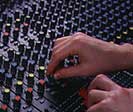| Author
|
Sidechain on Cubase
|
presto music

Started Topics :
1
Posts :
30
Posted : Jan 8, 2006 09:46
|
yep, this isn't even an argument, the low content of basslines- always in mono- there might be some odd exceptions, but for club bound tracks, no question here.
Don't belive me?
All you have to do is import a trance set (or any dance) into your sequencer of choice, play back, and switch between your stereo/mono on your master fader.
Concentrate on the bass as you switch back and forth. Notice something?
I guarantee 99.9% of tracks will have the bass completely intact in mono- that is- no loss at all!! in fact you probably notice a small amplitude increase in mono. That's cause they all are in mono for kick and bassline!
What you will also notice is a loss of other sounds in mono, (pads and effects, reverb etc) and this is the reason that a bassline for a club track should never be stereo- you cant afford to loose any of it, cause it's so important.
You can add stereo effects to the bassline, but this is usually only applied to he HF content- I'd say at the lowest 500Hz and above.
there is no need for IMO in this case. |

|
|
Freeflow
IsraTrance Full Member

Started Topics :
60
Posts :
3709
Posted : Jan 8, 2006 16:22
|
presto music - agreed
but still other genres of music has other boundaries.. thats good to add |

|
|
sub

Started Topics :
3
Posts :
12
Posted : Jan 9, 2006 23:13
|
excuse me,but what are we talking about when mentioning IMO?what is IMO?
and to go along with others,i agree on the fact that there is no need on stereo side-chaining on the low frequencies at all,mono is more than enough.on highs this could do some tricks.. |

|
|
Freeflow
IsraTrance Full Member

Started Topics :
60
Posts :
3709
Posted : Jan 10, 2006 13:47
|
nolightatend - thanks for the info 
anyway if one wants to make pan tricks with the kick, then a low cut can make that possible..
This can also be good to take a look at, from "sound on sound"
"When a signal is panned centrally, exactly the same signal will be output on both the left and right audio channels. If, on the other hand, the signal is panned fully to one side or the other, it's only output on one channel. If you listen to the results over loudspeakers, the doubled acoustic energy in the room when replaying a centrally-panned sound will produce a louder signal. And as we're talking about acoustic power, the signal level will appear to increase by about 3dB, compared to the level when only one channel is outputting the signal.
So if you pan from hard left, through centre, to hard right, it will sound as if the level rises slightly as it passes through the centre. To overcome this, mixer designers engineer the panning law to introduce a 3dB level drop at the centre, relative to the edges. However, if mono compatibility is important, a 6dB centre attenuation is necessary because the left and right channels are mixed together to make a derived mono. With the same signal in both channels (from a centrally panned signal), the voltage addition results in a 6dB level increase compared to the level of a signal in a single channel, so many broadcast desks employ a 6dB centre attenuation in their pan pots.
Manufacturers of mixers for general purpose often hedge their bets, and arrange a centre attentuation of 4.5dB, being halfway between the two camps! This is an excellent compromise in my opinion and seems to work well in all circumstances. However, bear in mind that because of the panning law, altering an instrument's stereo panning will also change its perceived level in the mix by a small but often significant amount. For this reason, I advocate panning sources to the required positions before crafting the final balance. Some people recommend getting the balance in mono first, but the balance will change by anything up to 6dB if you then pan sources around, which isn't very helpful. And if you think all this is complicated, spare a thought for surround sound panning laws!"
|

|
|
|